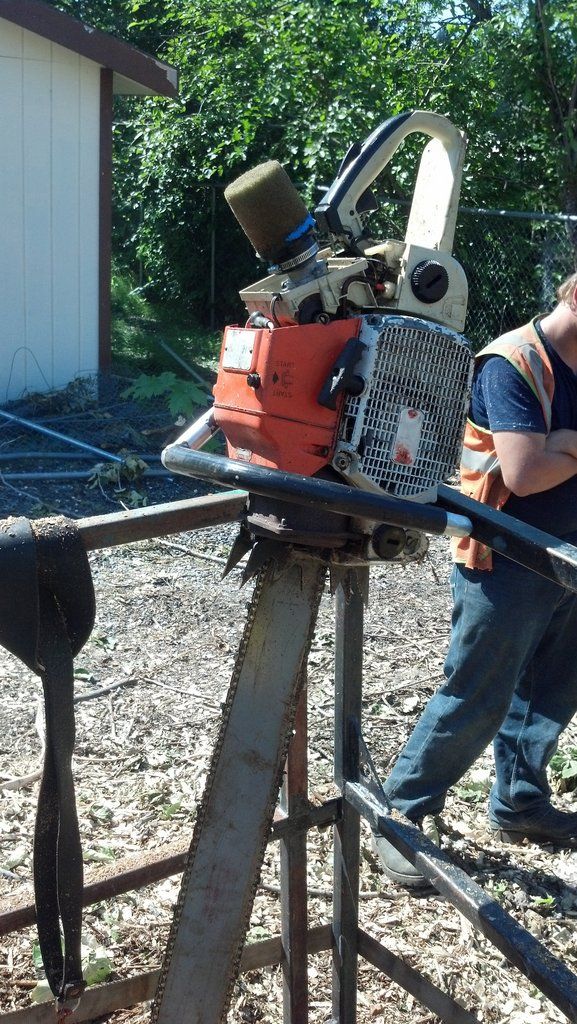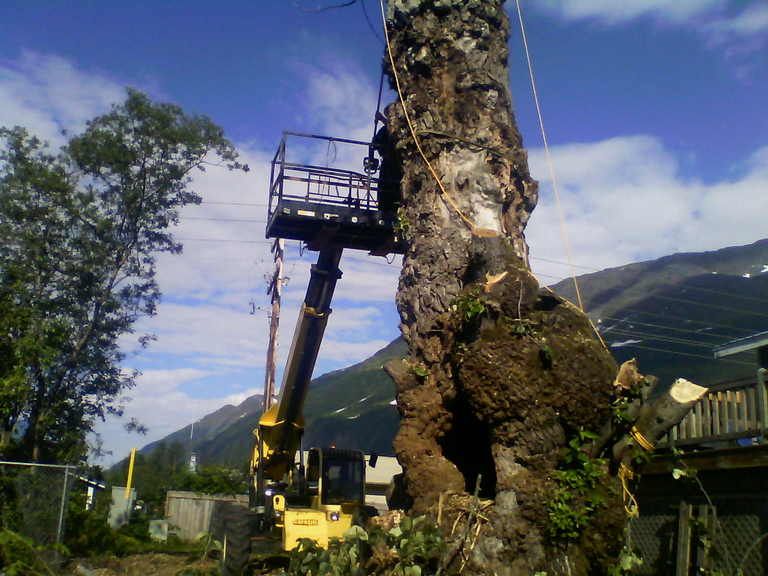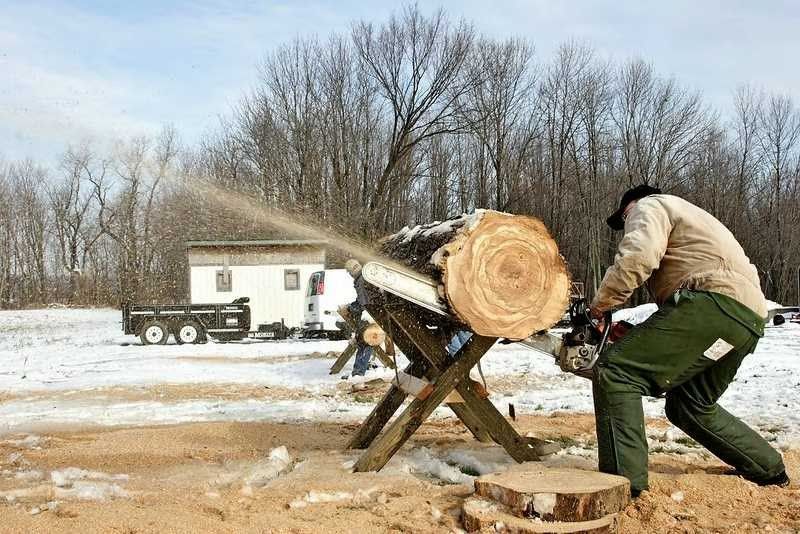Howdy,
Just got on this thread & wanted to add a few points distinguishing large Stihl saws from regular-duty equipment. The large Husqvarna saws are not discussed here, since they're shaped like sewing machines. (Uh-oh, I may have lost a few with that wise-crack).
The ergonomics of extra power allow a rhythm to develop with followthru made possible by high revs being maintained from the completion of one cut to the commencement of the next. By not having to push on the saw, the operator can relax during extended cutting, and is actually rested up by the time it is necessary to reposition for the next move. The extended length of the bigger saw has wider handle spacing, which effectively translates into more leverage for human hands to force the saw to pivot the bar around the fulcrum of the bucking teeth.
More power is sometimes truly needed, not just when a dull chain has to continue to be pressed into service. Occasionally a broken stem will need to be cut, which binds on a saw. The wood cracks & jumps as the bar progresses thru the cut, relieving the pressure of bent wood. This can pinch the chain, trapping the bar of lesser saws inside the kerf.
The need for a spare long bar for the big saws can't be denied. The set of extra bars & chains needed to make an MS880 truly versatile will nickel and dime a person to death. Of course, it's the customers money, so what do we care? Ever see a hospital operating room with just one scalpel on the tray? Catalog junkies (I resemble that remark) can tell that the Big Stihl bar is in it's own category because the bar bolts are fatter. The 075/084/090 bars are not interchangeable with bars from the 046/MS460 and smaller saws. The redundancy basically translates into the need for a new truck to transport all this extra gear.
The big saw has the horsepower to take out a bigger wood chip, so it also requires a larger sprocket matched with chain that will not fit on your small 046 unless installed as a set. This heavier chain has fewer links with rivets that are spaced farther apart, called .404 pitch. Each larger rivet passes thru 2 holes in each link. In the first 2 minutes of new chain break-in, these rivets wear smaller and the holes wear slightly out-of-round, which is what causes new chain to stretch. Stock MS880 chain has thicker .063 gauge drive links traveling along a slot in the bar that is wider, carving a wider trough thru the wood. The heavier chain on a long bar carries more inertia, resisting slowing down after release of the throttle. The chain is expensive, and purchasing a 100' roll is a great investment, since a single spare chain for a 41" bar uses 8' of chain all by itself. While you're at it, get a chain breaker, rivet spinner, and set of anvils. Dont forget that plastic laminated guide with the marking measurments to nail down to the work bench. Oh yeah, and get a bigger shop, too.
Our friend from Alaska noted the various configurations of teeth that are available on saw chain. 2 main distinctions are the 1) spacing of the toothed links on the chain, and 2) the shape of each tooth. I especially appreciate how the members posting on this discussion thread describe the selection of cutting attachments & horsepower in relation to the diameter of the tree trunks and the hardness/species of the wood being cut.
Round files are used for filing conventional saw chain, and chisel-bit files are for square filing chain used in softwood. This distinction is one of the subtle differences in tool selection for professionals. After several filings, old saw chain teeth get smaller, and the resulting wood chips are smaller, too. This can be compensated for by skillful sharpening with a file of smaller diameter. I have got to hand it to some artful loggers that are able to square file on older chain & still cut as quickly as my saws with newer round filed chain. Racing saws have the rivet heads filed flatter to lessen drag.
A video of How to Sharpen a Chainsaw in 5 Minutes is at:
http://youtu.be/RpwV5zdiwh8
Don't forget the 'big ol honkin vise' for your teak workbench that's for sale on craigslist. The video shows a skip tooth .050 gauge, 3/8" pitch chain being sharpened on a 28" Stihl 036 in less than 5 minutes. Full comp chain has more teeth, & takes considerably more time to sharpen.
To rinse the metal shavings out of the grooves, a very small amount of saw gas poured down a file from the handle end towards the tip can ressurrect an old file (not environmentally friendly). I shoulda filmed the taking down of the rakers, which is done with a flat file with smooth edges. The rat tail of a spare file is used to protect the edges of the teeth when filing the depth gauges. A guide is not needed, only counting the number of strokes (the same # for each tooth) is necessary. The number of file strokes on the raker partially determines how 'hungry' the chain will be in aggressively penetrating the kerf, and is usually a function of the age of the raker file. A contributing factor of self-feeding importance is the angle & direction of pushing on the round file during tooth sharpening. Pushing down will enlarge the gullet, creating a larger chip, while pushing backwards during filing will make it shallower, and cut less aggresively. The effect of proper sharpening on wood cutting performance is the amount of pressure the operator needs to control the saw safely, lessening fatigue.
That heavy combination of length, leverage & weight seems to have a homing device that pulls the tip of the bar down into the dirt at a moments notice, like Murphy's Law. A spare chain is needed for screwups just like this. Big saws decelerate more slowly after the cut is completed, which can lead to followthru into the dirt, whereas the chain on a smaller saw will already have spun to a stop. This phenomenon has led to many accidents, and is clearly noticeable with excessively loose chains on any size saw.
Other ways the 084 gets dull quicker than a small saw is that embedded dirt & other foreign objects are usually encountered in the lower portion of the tree trunk. The chain needs to be swapped out after each of these instances, depending on severity of obstruction. The large mass of .404 saw chain can power thru smaller nails or fence wire with relatively little effect. A longer bar will sometimes extend further past the back side of the work than a person may be aware of, and cut into a nearby rock or other unintended foreign object.
One time I found a set of 6 spark plugs & a carburator of primitive design inside the main fork of a Kellog Oak in Rogue River, Oregon. As the chain struck one spark plug after the other, I hallucinated that the ancient spark plugs were following me around inside that long closed-over cavity. Maybe the new saws will come equipped in the future with a metal detector, infrared proximity sensor, laser rangefinder, compass, and bubble level.
The selection of the front handle styles available on chainsaws has been addressed. Safety concious users should demand the full wrap handle on saws weighing over 25 pounds. Don't listen to the dry weight listed in the catalog, it doesn't account for fuel & oil, or the weight of the cutting attachment.
The real world (not in the catalog) version is that an 084 is rested on the right knee/thigh of the sawyer. This is right where the exhaust will burn your leg, and where the dawgs will getcha, but it is still the most effective way to position the saw when horizontally lining up a felling cut (sorry OSHA). The Humboldt cut requires the saw to be mostly upside down during the upward cut, virtually requiring a full wrap handle. Add uneven terrain to the mix, and a Flush Cutter is a distinct disadvantage. It is a challenge to even carry a smoking hot saw while dodging the felling spikes that seem to have the name of your knee written all over them. There are places that a full wrap handlebar won't allow an 084 to fit, which is why we have 046's. Wear leather gloves - those rubber ones will melt right to onto your pinky finger.
A chainsaw tooth travels around the bar at about 250 miles per hour. More chain speed can be obtained by swapping out the stock 7 tooth sprocket for the 8 tooth version. This speed comes at the cost of less power.
This speed can be helpful with shorter bars (under 32") and in softwood or Cottonwood trees. Dead oak always needs an attachment with full comp/.050/7 tooth sprocket.
BTW, during the power stroke, the piston of an 076 travels downwards a longer distance than a piston found in more modern engine designs like the 084. Stroker engines get more torque than engines that use higher RPM. The speed of the piston as it accelerates after the spark plug fires is 0 to thousands of miles per hour, then it brakes at an equally mind bending rate as it approaches bottom dead center & begins the cycle over again.
Anybody have these stats?











 Anybody have these stats?
Anybody have these stats? 